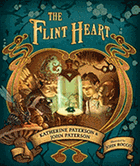
 Husband-and-wife team Katherine and John Paterson (Consider the Lilies) adopt the humorous and confident voice of consummate storytellers in this refashioning of Eden Phillpotts's 1910 tale.
Husband-and-wife team Katherine and John Paterson (Consider the Lilies) adopt the humorous and confident voice of consummate storytellers in this refashioning of Eden Phillpotts's 1910 tale.
"Many years ago, oh, let's say five thousand, more or less, there lived in the south of England,... tribes of people who had never thought to make anything out of metal, much less plastic." With this opening, the authors transplant readers to the Stone Age, where chiefs reign rather than kings, and one man, Fum, serves many roles--Lord Chief Justice and Poet Laureate among them. Fum is also a craftsman, and the young warrior Phuttphutt ("Phutt" for short) arrives at his door to request a charm that will give him "a hard heart" that will help put him in charge. "If I make you such a charm," Fum advises, "there'll be no more peace in the tribe until you are chief." Phutt, forewarned, commissions the charm anyway, and events evolve precisely as Fum had predicted. When at last Phutt dies, Fum buries the Flint Heart with him. But that is not the end of the wicked charm.
The Patersons establish the notion of lasting legends and enduring magic as they fast forward to "the England of one hundred years ago," and the Flint Heart's influence on the Jago family. Charles, age 12, and his father happen upon the heart while digging for something else, and its effect on Mr. Jago is instantaneous. Charles's younger sister Unity suggests they consult the pixies. With the help of the fairies, Charles and Unity break the enchantment, and gain compassion for others who would become victims of the charm. The King of the fairies comes to think of them as advisers, and Zagabog, who "knows everything," recruits them to repair other Flint Heart–related disasters. The authors subtly draw a distinction between Phutt, who sought the effects of the Flint Heart, and others who fall under its spell by happenstance.
John Rocco, with an acclaimed film background, creates artwork with a three-dimensional depth. He breathes life into the wildly diverse characters, including the endearingly self-important fairy De Quincey; a German-made damaged hot water bottle that goes by the name of Bismarck; the charming good cop/bad cop combination of the fairy King and Queen; and the seemingly omniscient Zagabog. The especially memorable Zagabog demonstrates that even the Thunder Spirit (who put the hex on the Flint Heart) is not uniformly bad--it's all in one's Point of View. This book could quickly become the family read-aloud favorite. It's old-fashioned bookmaking and storytelling, with a cast of characters and message for modern times.--Jennifer M. Brown

